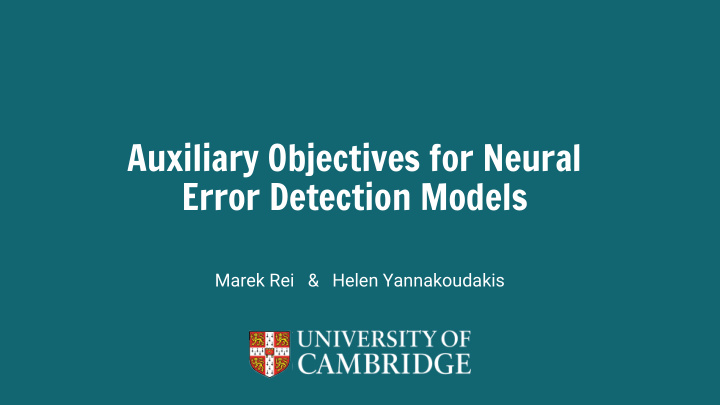



Auxiliary Objectives for Neural Error Detection Models Marek Rei & Helen Yannakoudakis
Error Detection in Learner Writing I want to thak you for preparing such a nice evening . 1. Independent learning Providing feedback to the student. 2. Scoring and assessment . Helping teachers and speeding up language testing. Downstream applications. 3. Using as features in automated essay scoring and error correction
Error Detection in Learner Writing Spelling error (8.6%) I want to thak you for preparing such a nice evening . Missing punctuation (7.4%) I know how to cook some things like potatoes . Incorrect preposition (6.3%) I’m looking forward to seeing you and good luck to your project . Word order error (2.8%) We can invite also people who are not members . Verb agreement error (1.6%) The main material that have been used is dark green glass .
Error Types in Learner Writing
Neural Sequence Labelling Rei and Yannakoudakis (2016, ACL); Rei et al. (2016, COLING)
Neural Sequence Labelling Rei and Yannakoudakis (2016, ACL); Rei et al. (2016, COLING)
Auxiliary Loss Functions Learning all possible errors from training data is not possible. • • Let’s encourage the model to learn generic patterns of grammar, syntax and composition, which can then be exploited for error detection. Introducing additional objectives in the same model. • • Helps regularise the model and learn better weights for the word embeddings and LSTMs. • The auxiliary objectives are only needed during training .
Auxiliary Loss Functions
Auxiliary Loss Functions 1. Frequency Discretized token frequency, following Plank et al. (2016) 5 3 8 4 8 5 7 9 5 8 0 10 My husband was following a course all the week in Berne .
Auxiliary Loss Functions 2. Native language The distribution of writing errors depends on the first language (L1) of the learner. We can give the L1 as an additional objective. fr fr fr fr fr fr fr fr fr fr fr fr My husband was following a course all the week in Berne .
Auxiliary Loss Functions 3. Error type The data contains fine-grained annotations for 75 different error types. _ _ _ RV _ _ _ UD _ _ _ _ My husband was following a course all the week in Berne .
Auxiliary Loss Functions 4. Part-of-speech We use the RASP (Briscoe et al., 2006) parser to automatically generate POS labels for the training data. APP$ NN1 VBDZ VVG AT1 NN1 DB AT NNT1 II NP1 . My husband was following a course all the week in Berne .
Auxiliary Loss Functions 5. Grammatical Relations The Grammatical Relation (GR) in which the current token is a dependent, based on the RASP parser, in order to incentivise the model to learn more about semantic composition. det ncsubj aux null det dobj ncmod det ncmod ncmod dobj null My husband was following a course all the week in Berne .
Evaluation: FCE First Certificate in English dataset (Yannakoudakis et al, 2011) 28,731 sentences for training, 2,720 sentences for testing,
Evaluation: CoNLL-14 CoNLL 2014 shared task dataset (Ng et al., 2014)
Alternative Training Strategies Two settings: Three datasets: Pre-train the model on a Chunking dataset with 22 1. 1. different dataset, then labels (CoNLL 2000). fine-tune for error detection. NER dataset with 8 labels 2. 2. Train on both datasets at the (CoNLL 2003). same time, randomly choosing the task for each iteration. 3. Part-of-speech tagging dataset with 48 labels (Penn Treebank).
Alternative Training Strategies Pre-training Switching Aux dataset FCE CoNLL-14 CoNLL-14 Aux dataset FCE CoNLL-14 CoNLL-14 TEST1 TEST2 TEST1 TEST2 None 43.4 14.3 21.9 None 43.4 14.3 21.9 CoNLL-00 42.5 15.4 22.3 CoNLL-00 30.3 13.0 17.6 CoNLL-03 39.4 12.5 20.0 CoNLL-03 31.0 13.1 18.2 PTB-POS PTB-POS 44.4 14.1 20.7 31.9 11.5 14.9
Additional Training Data Training on a larger corpus (17.8M tokens): Cambridge Learner Corpus (Nicholls, 2003) • NUS Corpus of Learner English (Dahlmeier et al., 2013) • • Lang-8 (Mizumoto et al., 2011) Task F 0.5 R&Y (2016) F 0.5 FCE DEV 60.7 61.2 FCE TEST 64.3 64.1 CoNLL-14 TEST1 34.3 36.1 CoNLL-14 TEST2 44.0 45.1
Conclusion • We performed a systematic comparison of possible auxiliary tasks for error detection, which are either available in existing annotations or can be generated automatically. POS tags, grammatical relations and error types gave the largest • improvement. • The combination of several auxiliary objectives improved the results further. Using multiple labels on the same data was better than using • out-of-domain datasets. • Multi-task learning also helped with large training sets , getting the best results on the CoNLL-14 dataset.
Thank you!
Recommend
More recommend